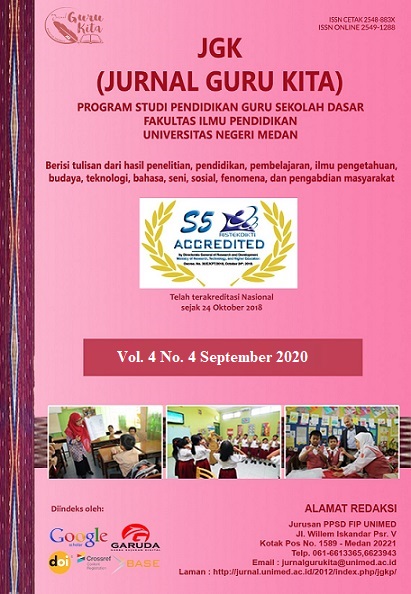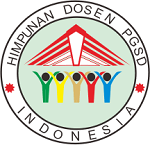PERAN GURU DAN STRATEGI DALAM MENINGKATKAN PARTISIPASI SISWA
DOI:
https://doi.org/10.24114/jgk.v5i4.27984Keywords:
teacher’s role, strategies, active learners, participationAbstract
Abstract: Teacher™s Role and Strategies in Enhancing Students™ Active Participation. Pupils™ active engagement in the classroom is important as implementing student-centered learning and increase students™ critical thinking. Dornyei (2007) claimed that the teacher is one of the factors that can influence students™ willingness to communicate. This study aimed to investigate teachers™ role and strategies in enhancing EFL learners™ tendency to talk. The researcher started to explore teacher™s contribution in supporting students™ self-confidence and effective strategies that could be applied in the classroom. This research used literature research methodology to explore the roles and approaches. The findings showed that the roles of the educators are as facilitator, and teacher™s attitude such as teacher™s wait time and techniques in delivering the message, influence students™ participation significantly during the learning process. Also, there are three techniques to reduce students™ reticence namely teacher-fronted strategy, facilitator-oriented strategy, and learner-oriented strategy. Finally, some suggestions have been remarked in the last chapter of this research. Keywords: Teacher™s role, Strategies, Active learners, participation Abstrak: Peran Guru dan Strategi Meningkatkan Partisipasi Siswa. Peran aktif siswa dikelas sangat penting dalam mengaplikasikan pembelajaran berbasis siswa dan juga untuk meningkatkan kemampuan berfikir kritis. Dornyei (2007) menyatakan bahwa guru adalah salah satu faktor yang dapat mempengaruhi keinginan siswa untuk berbicara dikelas. Penelitian ini bertujuan untuk menelaah peran serta strategi yang dapat dilakukan untuk meningkatkan partisipasi siswa. Kontribusi guru dalam menumbuhkan motivasi siswa serta strategi yang efektif untuk mengatasi permasalahan siswa akan dibahas secara terperinci. Metode yang digunakan dalam meneliti kedua komponen tersebut adalah studi literatur. Hasil penelitian menunjukkan bahwa terdapat tiga peran penting guru, yaitu guru sebagai fasilitator, penggunaan waktu tunggu dikelas oleh guru dan juga teknik dalam penyampaian umpan balik. Juga, terdapat tiga strategi yang dapat digunakan yaitu strategi teacher™fronted, facilitator oriented dan juga learner oriented. Selain itu, saran untuk meningkatkan motivasi siswa berbicara dikelas akan diuraikan pada bagian akhir penelitian ini. Kata Kunci: Peran Guru, Strategi, Siswa, partisipasiReferences
Bryman, A. (2016). Social research methods (5th Ed.). Oxford, UK: Oxford University Press.
Cao, Y. (2011). Investigating situational willingness to communicate within second language classrooms from an ecological perspective. English Language Centre,
Dornyei, Z. (2007). Creating a motivating classroom environment. In J. Cummins, & C. Davison (Eds.), International Handbook of English Language teaching (pp.719-731). doi:10.1007/978-0-387-46301-8_47
Harmer, J. (2015). The Practice of English Language Teaching. Slovakia: Pearson Education
Kang, S. (2005). Dynamic emergence of situational willingness to communicate in a second language. System, 33(2), 277-292. doi:10.1016/j.system.2004.10.004
Lee, W., & Ng, S. (2010). Reducing student reticence through teacher interaction strategy. ELT Journal, 64(3), 302-313. Retrieved from https://doi-org.ezproxy.lib.monash.edu.au/10.1093/elt/ccp080
Mesgarshahr, A., & Abdollahzadeh, E. (2014). The impact of teaching communication strategies on EFL learners™ willingness to communicate. Studies in Second Language Learning and Teaching, 4(1), 51-76. doi:10.14746/ssllt.2014.4.1.4
Mirsane, M., & Khabiri, M. (2016). The effect of teaching communicative strategy on EFL learners' willingness to communicate. Theory and Practice in Language Studies, 6(2), 399-407. doi:http://dx.doi.org/10.17507/tpls.0602.24
Safitri, D. (2019). Menjadi Guru Profesional. Tembilahan - Riau: PT. Indragiri Dot Com
Vongsila, V., & Reinders, H. (2016). Making asian learners talk: Encouraging willingness to communicate. RELC Journal, 47(3), 331-347. doi:10.1177/0033688216645641
Wen, W. P., & Clement, R. (2003). A Chinese conceptualisation of willingness to communicate in ESL. Language Culture and Curriculum, 16(1), 18-38. doi:10.1080/0790831030866
Zarrinabadi, N. (2014). Communicating in a second language: Investigating the effect of teacher on learner's willingness to communicate. System, 42(1), 288-295. doi: 10.1016/j.system.2013.12.014
Downloads
Published
How to Cite
Issue
Section
License
Authors published with the JGK (Jurnal Guru Kita) agree to the following terms:
- Authors retain copyright and grant the journal the right of first publication with the work simultaneously licensed under a Creative Commons Attribution License (CC BY-SA 4.0) that allows others to share the work with an acknowledgment of the work's authorship and initial publication in this journal.
- Authors are able to enter into separate, additional contractual arrangements for the non-exclusive distribution of the journal's published version of the work (e.g., post it to an institutional repository or publish it in a book), with an acknowledgment of its initial publication in this journal.
- Authors are permitted and encouraged to post their work online (e.g., in institutional repositories or on their website) prior to and during the submission process, as it can lead to productive exchanges, as well as earlier and greater citation of published work. (See The Effect of Open Access)


























